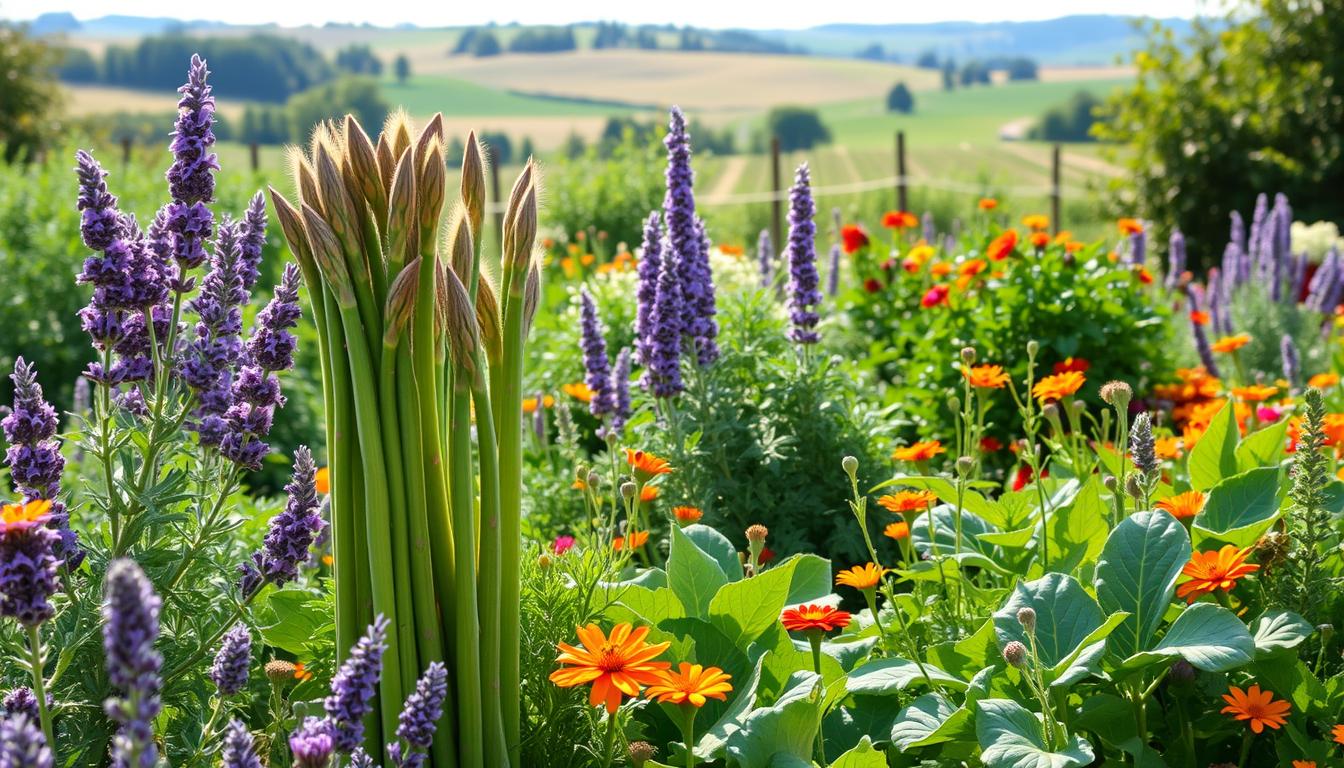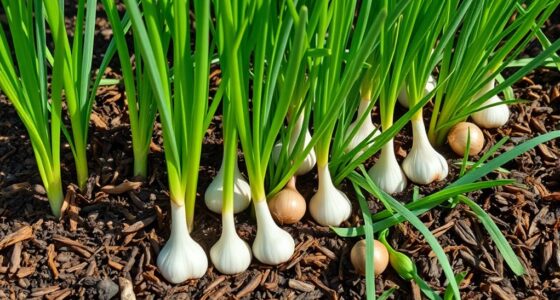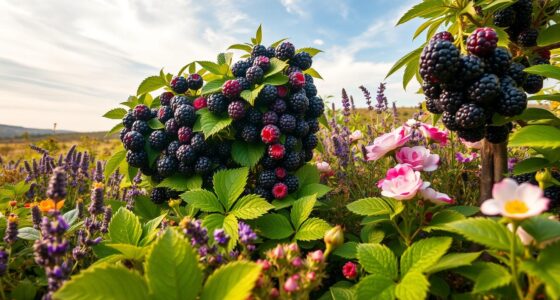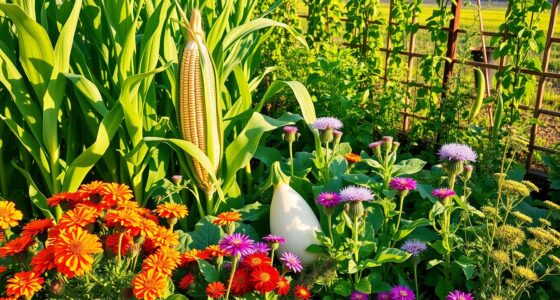Imagine stepping into your garden, the sun warming your skin, and the earthy aroma of freshly turned soil filling your lungs. You look over at your asparagus bed, a personal favorite that represents years of patience and cultivating growth. But did you know that your beloved asparagus can thrive even more effectively with the right companions? By selecting the optimal asparagus companion plants, you can enhance not just their growth but also the overall health of your garden. In this article, we’ll explore the best plants to grow with asparagus, uncovering a world of herbs, vegetables, and flowers that will turn your garden into a flourishing haven. Let’s discover how these asparagus garden companions can support each other and create a thriving ecosystem right in your backyard.
Key Takeaways
- Companion planting enhances the growth and health of asparagus.
- Choosing the right asparagus companion plants promotes pest control and soil health.
- Optimal companions include specific herbs, vegetables, and flowers.
- Avoid certain plants like onions and garlic that can negatively affect your asparagus.
- Planning your garden layout is essential for maximizing the benefits of companion planting.
Understanding Asparagus Growth Requirements
Understanding the essential asparagus growth requirements is vital for cultivating a thriving asparagus garden. This perennial vegetable thrives in optimal conditions, requiring specific soil, light, and water factors to flourish.
Ideal Soil Conditions
Asparagus prefers well-draining soil rich in organic matter. Soil pH around 7.0 is ideal for asparagus growth, allowing for better nutrient absorption. Ensuring excellent drainage is crucial, as it helps prevent root rot, a common issue in poorly drained soils. Incorporating organic materials, such as compost, enhances soil structure and fertility, making it one of the ideal plants for asparagus beds.
Light and Water Needs
Full sun exposure is critical for healthy asparagus growth. These plants thrive in bright conditions, receiving at least 6 to 8 hours of sunlight daily. Equally important is consistent moisture, particularly during the first couple of years. Regular watering helps establish robust root systems, which contribute to higher yields in subsequent growing seasons. Familiarizing yourself with these asparagus growth requirements ensures that your garden remains productive and bountiful.
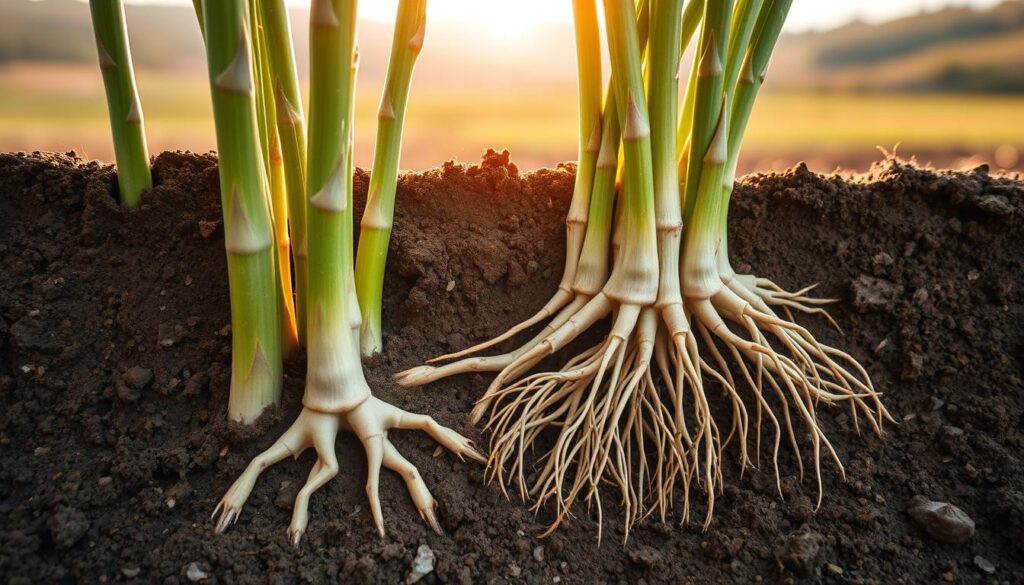
Benefits of Companion Planting
Embracing companion planting for asparagus reveals numerous advantages that can transform your gardening experience. Many gardeners find that specific plant combinations lead to healthier crops and abundant yields. Understanding the benefits of companion planting can help you make informed choices about the most suitable asparagus planting partners.
Pest Control Advantages
One of the standout benefits of companion planting is natural pest control. Certain plants can act as repellents to common pests that threaten asparagus, such as the asparagus beetle. Incorporating these natural deterrents into your garden can minimize reliance on chemical pesticides. For example, planting herbs like basil alongside your asparagus can discourage unwanted insects while providing additional flavor benefits to your harvest.
Improved Soil Health
Another significant aspect of companion planting for asparagus is the enhancement of soil health. Some companion plants, like legumes, have the ability to fix nitrogen in the soil, which increases nutrient availability for your asparagus and other nearby crops. This improved soil health not only supports robust asparagus growth but also fosters a more balanced ecosystem, which can lead to higher yields and greater overall plant vitality.
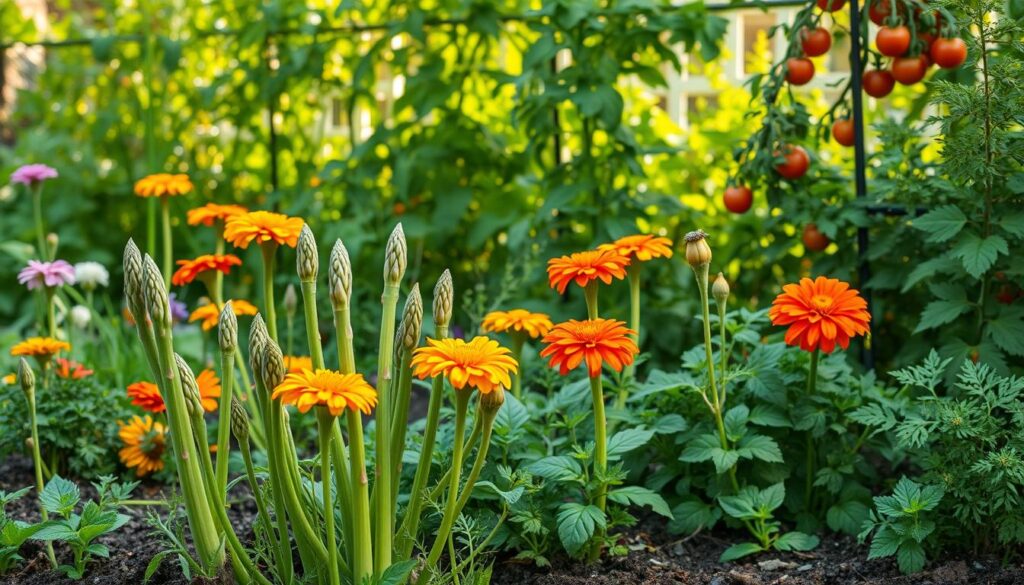
Top Companion Plants for Asparagus
Choosing the best plants to grow with asparagus enhances both yield and health in your garden. Asparagus garden companions are essential for promoting pest resistance, nutrient sharing, and overall growth. Here are some excellent options to consider.
Tomatoes: A Great Pairing
Tomatoes and asparagus make a great pairing in the garden. The solanine released by tomatoes helps deter common asparagus pests. On the other hand, asparagus provides valuable protection for tomatoes by guarding them against nematodes. When planted together, these two crops can thrive harmoniously while contributing to each other’s health.
Basil: Flavor and Growth Boost
Basil serves as another amazing companion for asparagus. Its distinctive aroma has the power to confuse and repel harmful insects. Additionally, basil attracts pollinators, enhancing the garden’s ecosystem. By incorporating basil, you not only enrich your meals with flavor but also support the growth of your asparagus plants.
Marigolds: Pest Deterrents
Including marigolds in your asparagus garden is a smart choice for pest control. Their bright, vibrant flowers attract beneficial insects while naturally warding off nuisances like the asparagus beetle. The presence of marigolds can significantly enhance the overall health of your garden, making them one of the best plants to grow with asparagus.
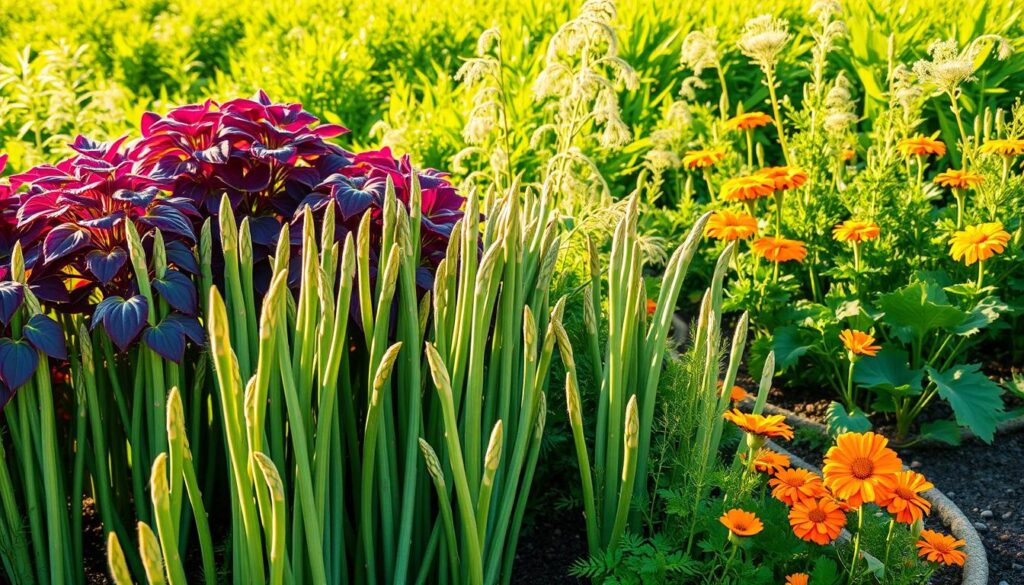
| Companion Plant | Benefits |
|---|---|
| Tomatoes | Deter pests and protect against nematodes |
| Basil | Repels harmful insects and attracts pollinators |
| Marigolds | Draws beneficial insects and deters pests |
Herbs that Thrive with Asparagus
Growing herbs alongside asparagus can enhance your garden’s health and productivity. Companion planting with herbs not only complements asparagus but creates a beneficial ecosystem that encourages growth and deters pests. Here are two herbs that are excellent asparagus herb companions:
Oregano: Companion Benefits
Oregano is a robust herb known for its ability to repel common garden pests. Its strong scent can deter unwanted insects, providing a natural layer of protection for your asparagus. As a companion, oregano thrives in similar soil conditions, making it an ideal choice. In addition, it attracts beneficial insects that help maintain the health of your asparagus plants, allowing them to flourish.
Thyme: Sustainable Growth Partner
Thyme is a low-growing herb that will coexist harmoniously with asparagus. It enjoys the shade provided by taller asparagus plants during the hot summer months, which helps it thrive without competing for resources. Thyme’s flowers attract pollinators and other beneficial insects, which support overall garden health. This synergy promotes a thriving garden environment where both herbs and asparagus can flourish together.
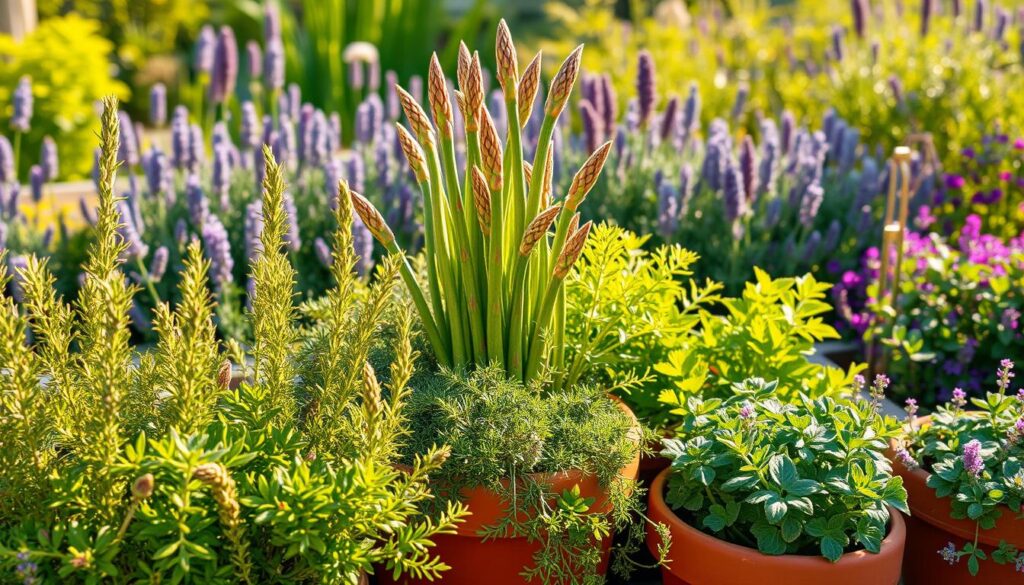
| Herb | Benefits | Growth Conditions |
|---|---|---|
| Oregano | Repels pests, attracts beneficial insects | Well-drained soil, full sun |
| Thyme | Thrives in shade, attracts pollinators | Loose soil, moderate sun |
Vegetables That Complement Asparagus
Creating a thriving asparagus vegetable garden requires careful selection of companion plants. Vegetables that complement asparagus not only enhance yield but also promote a healthier garden ecosystem. Two excellent choices for companion planting include peppers and spinach, both of which have distinct benefits when grown alongside asparagus.
Peppers: Shared Space Harmony
Planting peppers with asparagus fosters an environment of shared space harmony. Both plants have similar growing requirements, which makes them compatible garden partners. Peppers thrive in the same soil conditions as asparagus and can help maximize the use of your garden space. This combination leads to efficient gardening, allowing you to enjoy a bountiful harvest from both crops.
Spinach: Nutrient-Rich Neighbors
Another plant that proves advantageous in your asparagus vegetable garden is spinach. As a beneficial ground cover, spinach retains soil moisture and reduces weed growth around asparagus. These benefits create an optimal environment for both plants, enhancing their overall health and productivity. The combination of spinach and asparagus helps maintain soil nutrients, fostering a more resilient garden.
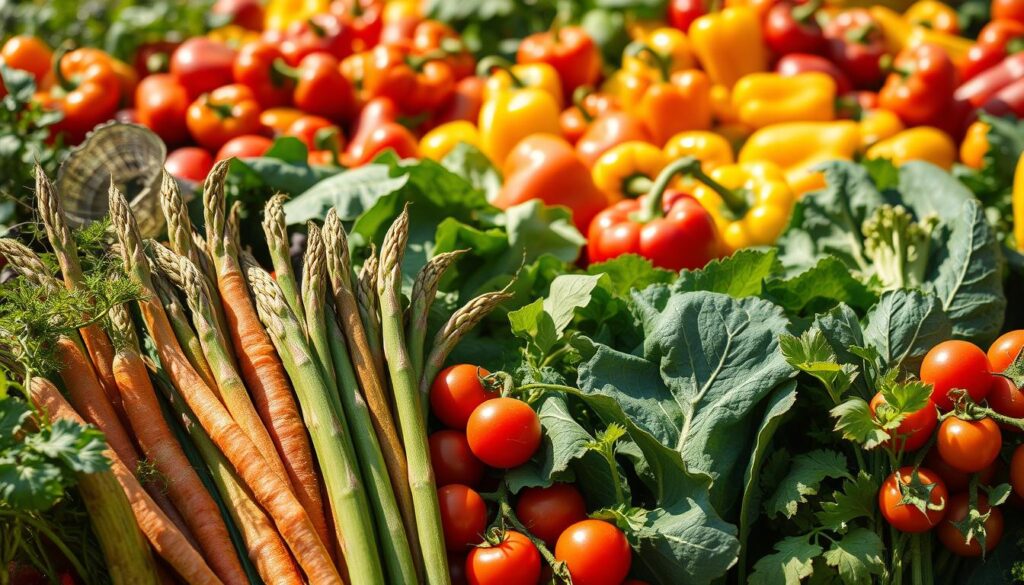
Flowers That Attract Beneficial Insects
Incorporating flowers into your garden serves as a vibrant strategy for enhancing the ecosystem. Flowers that attract beneficial insects not only provide aesthetic appeal but also contribute significantly to the health of your plants. Specifically, certain varieties act as companion flowers for asparagus, enhancing growth while contributing to pest management.
Nasturtiums: Beautiful and Useful
Nasturtiums are remarkable companion flowers for asparagus. Their bright blooms can draw the attention of pests away from your valuable crops. These flowers not only add beauty to your garden but also enrich the soil with nitrogen, benefiting the asparagus and surrounding plants.
Borage: Nutrient Provider
Borage is another exceptional choice among flowers that attract beneficial insects. Its striking flowers are a magnet for bees and other pollinators, which enhances overall fruit and vegetable production. This plant also delivers essential nutrients to the soil, promoting a robust growing environment for asparagus and its companion flowers. The presence of these pest-deterring flowers helps create a balanced garden ecosystem.
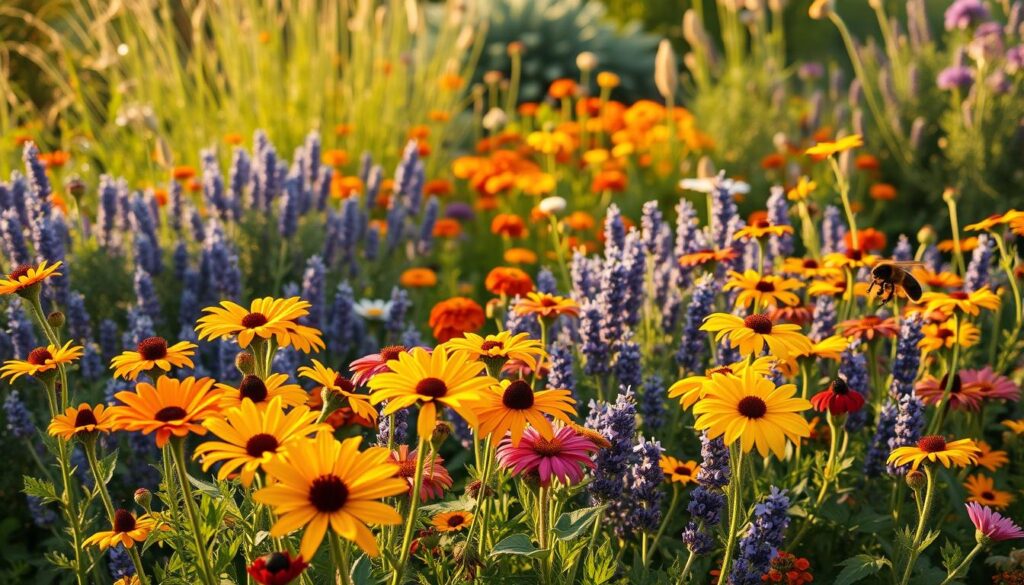
Plants to Avoid Near Asparagus
When planning your garden layout, it’s important to consider the plants to avoid near asparagus. Certain species can impede the growth of asparagus and lead to companion planting mistakes that hinder your overall yield. Understanding which plants can negatively impact asparagus will help you create a thriving garden environment.
Onions and Garlic: Sensitivity Issues
Onions and garlic belong to the allium family and can cause sensitivity issues for asparagus. These plants compete for essential nutrients, leading to stunted growth in your asparagus. If you want your asparagus to flourish, it’s wise to keep onions and garlic at a safe distance.
Potatoes: Competition for Resources
Potatoes are another plant to avoid near asparagus due to their heavy feeding habits. These starchy vegetables absorb significant amounts of nutrients from the soil, creating competition for resources. Ensuring that potatoes stay clear of your asparagus patch allows your crops to access the nutrients they require for optimal growth and yield.

| Plant Type | Effect on Asparagus |
|---|---|
| Onions | Competes for nutrients, inhibits growth |
| Garlic | Inhibits asparagus growth through nutrient competition |
| Potatoes | Heavy feeders that rob asparagus of resources |
How to Organize Your Garden Layout
When it comes to organizing garden layout, a well-planned design maximizes both beauty and productivity. A successful asparagus garden design takes into account not only the plants themselves but also their companions. Properly situated plants encourage healthy growth while ensuring they complement one another in terms of nutrients and space.
Planting Techniques for Companion Plants
Clever planting techniques play a vital role in companion planting. Interspacing taller crops with shorter ones yields optimal results. This approach not only helps to shade smaller plants but also captures more sunlight, enhancing growth. Consider using a layout where your asparagus is positioned among these companions, creating a thriving ecosystem within your garden.
Spacing Recommendations for Optimal Growth
Spacing recommendations for asparagus suggest planting them 12-14 inches apart. This distance prevents overcrowding and allows for essential air circulation. It ensures that each plant has sufficient resources, promoting healthier and more vigorous growth. Maintain this space while arranging your companion plants to create a harmonious garden, benefiting all plants involved.
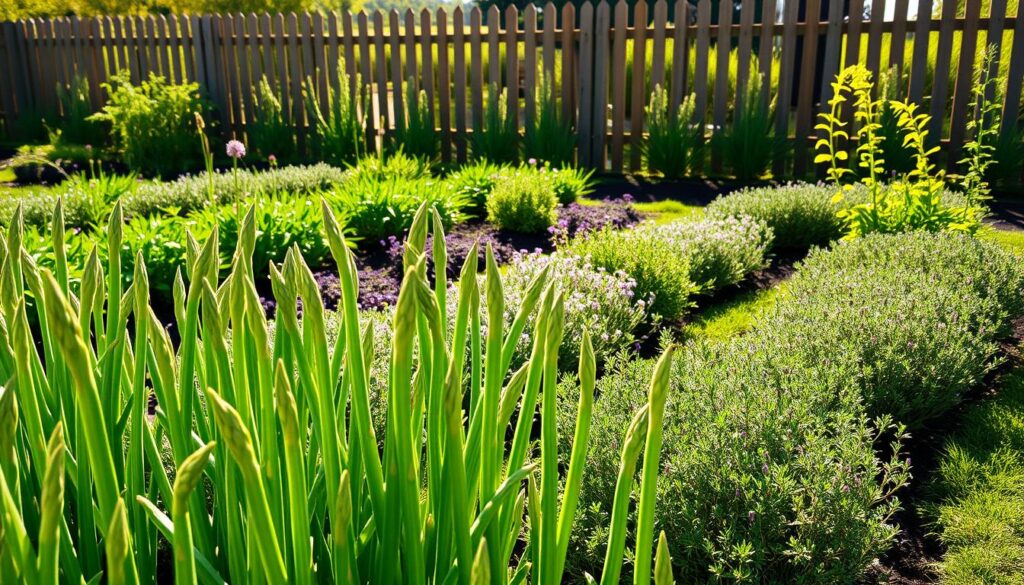
Seasonal Considerations for Companion Planting
Timing plays a critical role in implementing effective seasonal planting strategies. Understanding companion planting by season will enhance your garden’s productivity and health. Spring and summer present unique opportunities for planting alongside asparagus, promoting growth and ensuring optimal conditions for both your primary crop and its companions.
Spring Planting Strategies
In spring, you can start sowing fast-growing plants like spinach alongside asparagus. These crops not only grow quickly but also provide ground cover, helping to retain moisture during the asparagus growth phase. Employing these techniques aids in maximizing space and resources effectively in your garden.
Summer Companion Choices
As the growing season transitions into summer, consider integrating peppers and tomatoes into your asparagus garden. Both thrive in warmer temperatures and will grow well as asparagus begins to mature. The understanding of seasonal dynamics allows you to benefit from varied harvests and maintains soil health as different plants interact.
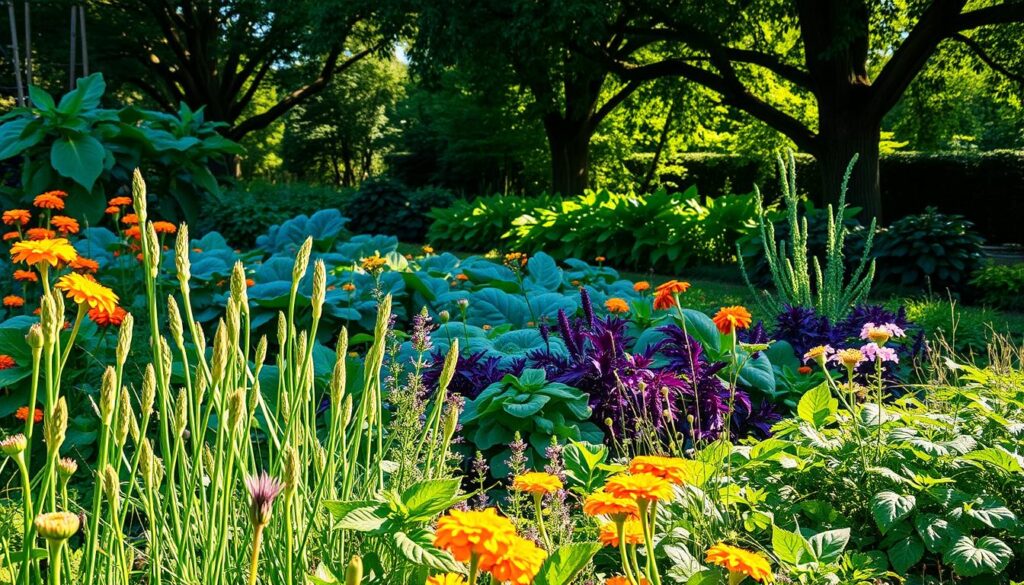
| Season | Companion Plants | Benefits |
|---|---|---|
| Spring | Spinach | Moisture retention, quick growth |
| Summer | Peppers, Tomatoes | Thrives in warm conditions, varied harvests |
Maintaining Healthy Companion Plant Relationships
Maintaining companion plant health is crucial for the success of your asparagus garden. Regular care and attention can promote positive interactions between asparagus and its companions. By knowing what to look for and how to respond, you’ll create a flourishing environment for all plants involved.
Regular Care and Attention
Your effort in asparagus plant care should include routine checks and maintenance. Regular watering, appropriate fertilization, and ensuring good soil quality can significantly improve relationships between plants. Consider implementing crop rotation to prevent nutrient depletion and pest build-up in the soil.
Monitoring Growth and Health
Monitoring the growth and health of both asparagus and its companion plants is important for optimizing plant relationships. Look for signs of stress or imbalance, such as yellowing leaves or stunted growth. This vigilance allows you to take corrective measures early, ensuring a thriving garden.
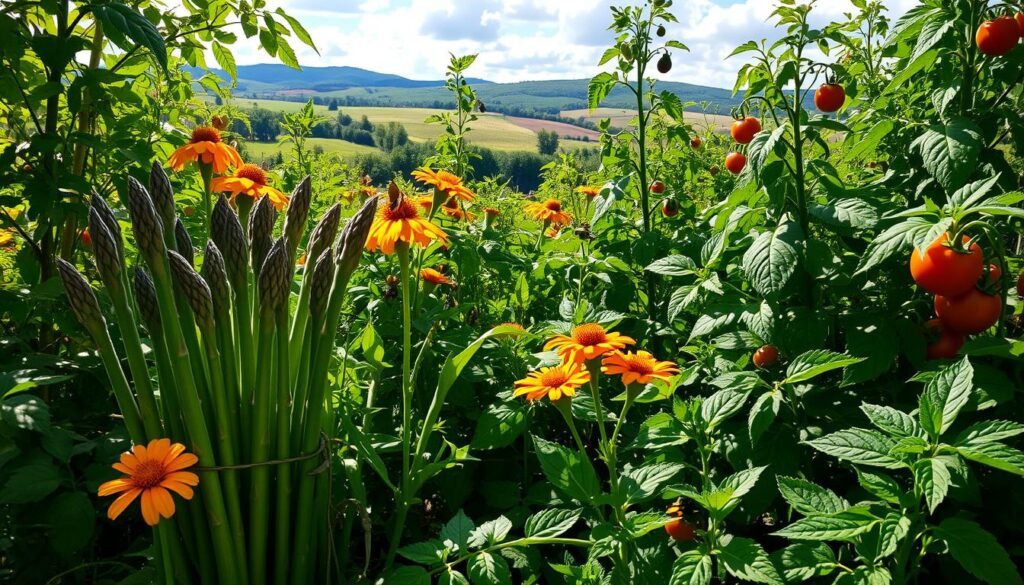
| Care Aspect | Best Practices |
|---|---|
| Watering | Consistent moisture without waterlogging |
| Fertilization | Natural fertilizers to enhance nutrient levels |
| Soil Quality | Regular testing and amendments for pH balance |
| Crop Rotation | Alternate crops to boost soil fertility and break pest cycles |
Common Pests and How to Manage Them
Maintaining a robust asparagus garden involves recognizing and addressing common pests for asparagus. Identifying these pests early can save your plants from serious damage. Asparagus beetles and aphids are frequent visitors, posing threats to healthy growth.
Identifying Garden Pests
To effectively implement pest management strategies, focus on monitoring your garden regularly. Look for signs of asparagus beetles, such as skeletonized leaves, and clusters of small aphids that can weaken your plants. Early detection ensures that you take the right steps promptly, minimizing the impact on your asparagus harvest.
Natural Pest Control Methods
Engaging in organic pest control for asparagus can provide sustainable solutions to your gardening challenges. Introducing beneficial insects, like ladybugs, can naturally decrease aphid populations. Additionally, using insecticidal soap can eliminate pest infestations without harming the environment. Combining these strategies enhances the health of your asparagus while preserving the ecosystem around it.
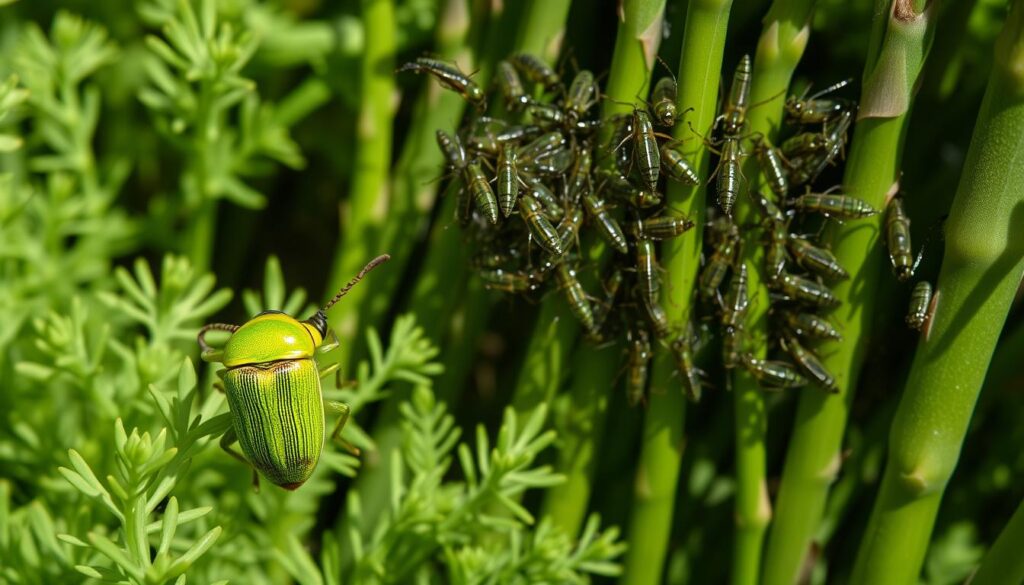
Harvesting Tips for Asparagus and Companions
Understanding the right time to harvest both asparagus and its companion plants plays a critical role in optimizing harvest yield. Timing significantly influences the flavor, nutrition, and overall quality of your produce. Following asparagus harvesting tips can lead to a more fruitful gardening experience.
Timing Your Asparagus Harvest
Asparagus should be harvested when the spears reach a height of 6-8 inches. Aim to collect them before they begin to fern out, typically in the spring months. This practice ensures that you enjoy the best flavor and tenderness, ensuring an optimal catch for your meals.
Harvesting Companion Plants for Best Results
For companion plant harvesting, timing is equally essential. Focus on harvesting plants like spinach and radishes during their peak growing seasons. By doing so, you will not only enjoy fresh produce but also maximize the nutrients available from these plants. Careful attention to the growth stage of each companion plant can lead to higher quality yields as well as a better overall gardening experience.
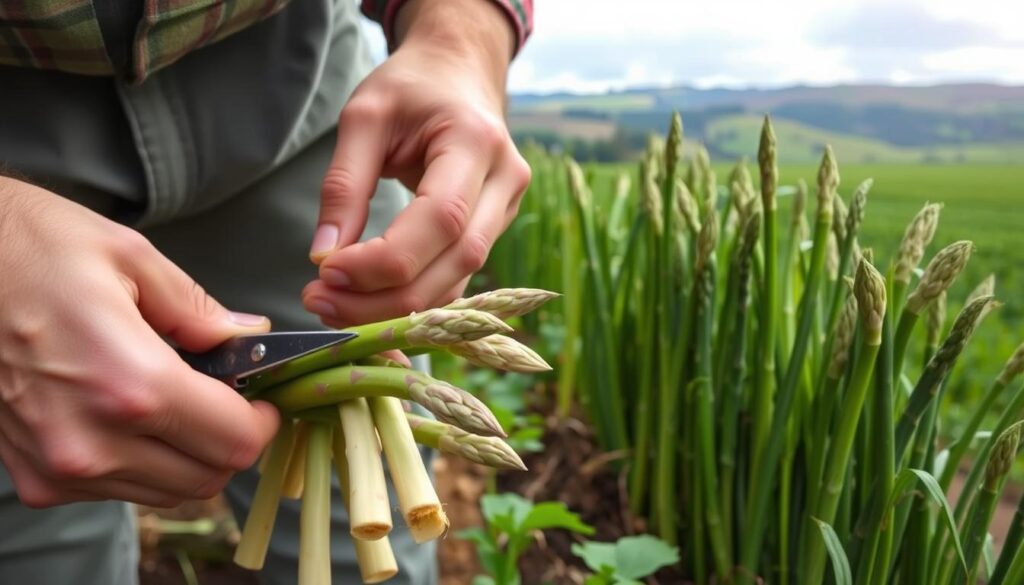
Conclusion: Maximizing Your Asparagus Garden
As you wrap up your journey into the world of asparagus gardening, it’s essential to recognize how companion planting can revolutionize your approach. Understanding the relationships between asparagus and its supporting plants not only enhances growth but also underscores the numerous companion planting benefits—including natural pest control and improved soil health. Implementing these strategies will not only aid in maximizing asparagus garden health but set the stage for ongoing productivity.
Throughout this exploration, you’ve learned about various planting partners, from tomatoes to herbs, that can contribute to your success. Each choice you make in your garden can lead to flourishing relationships between plants, maximizing their capabilities to thrive together. By embracing this knowledge, you’re paving the way for asparagus gardening success that flourishes season after season.
As you continue to experiment and refine your practices, remember that every garden tells a unique story. Adaptation and patience are keys to watching your efforts yield a rewarding harvest. Enjoy the process, and may your garden be filled with vibrant asparagus and its delightful companions!
